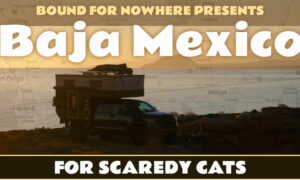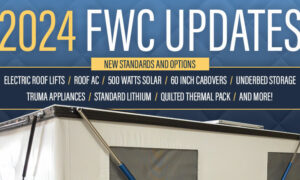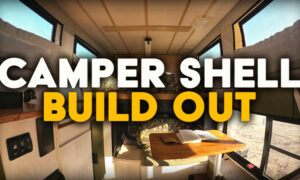World traveler, Ron Moon, explains why he keeps leaving his Four Wheel Camper all over the American continent. Maybe we all need two truck campers. Or three?

For his interview, Ron cautioned us about the idea of, “Someday”. Admittedly, we are as guilty of saying, “someday” as anyone might be. Someday we’ll live full-time on the road. Someday we’ll take a truck camper to Baja. Someday we’ll stop interviewing people about driving to Alaska and do it ourselves. Someday…
Ron says stop the “someday”, and set a date. You have to admire the simplicity and directness of this idea. Instead of saying, “Someday I’ll buy a truck camper and travel”, try saying, “On October 1st, we’re going to load our new camper on our new truck and drive out west for three months visiting national parks”. Doesn’t that feel good? Now we’re actually going to make this happen!
Of course, Ron’s personal “someday” list is enough to make most of us run to the sofa to watch television. He’s not talking about seeing Yellowstone folks. Ron’s aim is multi-national, cross-cultural, and going the distance. Try saying, “Next October I’m going to fly to Australia, buy a truck and camper in-country, and spend a year down under”. Did that make you freak out a little? Or are you beyond excited about that plan? Admittedly, we are both.
Fortunately, Ron has some answers on that front. He and his wife, Viv, have become experts on traveling from continent to continent and exploring the natural wonders each destination has to offer. Even better, Ron reveals some of his best advice on exactly how this type of adventure travel is accomplished. Scared out of your mind? He’s got that covered too.
Stop the somedays. Set a date. The world is waiting.
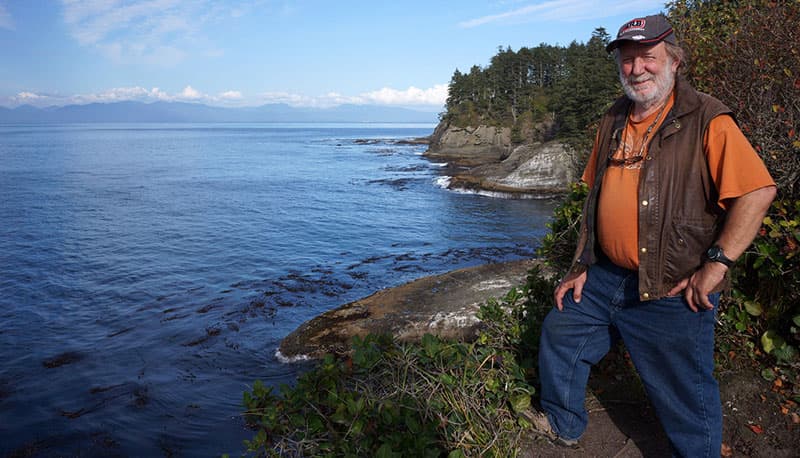
Above: Ron Moon, Cape Flattery in Washington
TCM: Your world-wide travel experiences are extensive. Can you give us a top line of where you’ve been and how you ended up exploring the United States, Canada, and Mexico?
Ron: In 2007, after numerous trips there, we shipped a vehicle to Africa and stayed ten months. We’ve been back five times since then. In 2008, we traveled through Russia, Mongolia, and Kazakhstan. We have also traveled through Europe, but – without many wild areas to explore – it doesn’t have the same appeal.
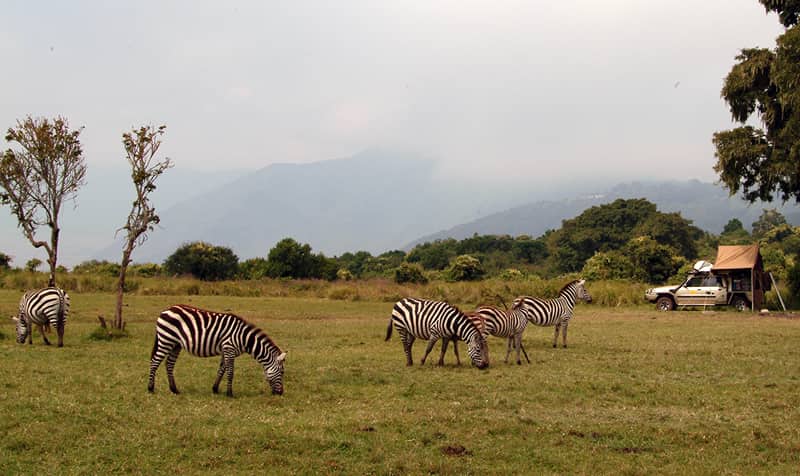
Above: Ngorongoro National Park, Tanzania, Africa
In 2011 we decided to visit the Americas. We shipped our rig to South America and traveled to the southernmost point and then wandered up to San Diego. As is our pattern, we left that vehicle in storage, went back to Australia, and then returned six months later to drive up to Prudhoe Bay, Alaska.
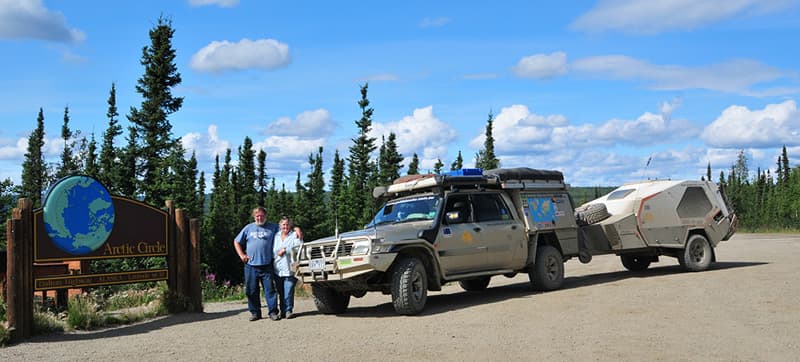
Above: Their rooftop tent and trailer at the Arctic Circle
TCM: The concept of purchasing a rig on another continent and leaving it there for exploration is fascinating. Why not just keep using the vehicle you initially imported from Australia?
Ron: A foreign vehicle is only allowed in America for 12 months, so we decided to ship our first truck back home and purchase an American vehicle and keep it there. We basically had a pickup with a canopy and a rooftop tent. Through South America and North America, we also towed a trailer with sleeping quarters.
For our next rig, we wanted something that would stay in North America. Our goal was to travel off the beaten path and explore two-track dirt and gravel roads. That’s what led us to a truck camper. We liked Four Wheel Campers because of their small size, low weight, and proven durability.
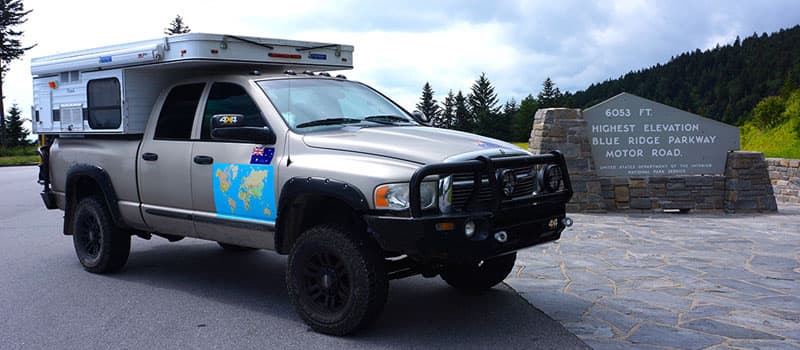
Above: Viv and Ron’s Four Wheel Camper on the Blue Ridge Parkway
TCM: How did you decide on a Four Wheel Camper rig?
Ron: We decided on a Four Wheel Camper from recommendations from friends like Jonathan and Roseann Hansen, Founders of the Overland Expo. They are very experienced overland travelers and highly recommended a Four Wheel Camper. I listened to them and said, “If it’s good for them, it’s good for me.”
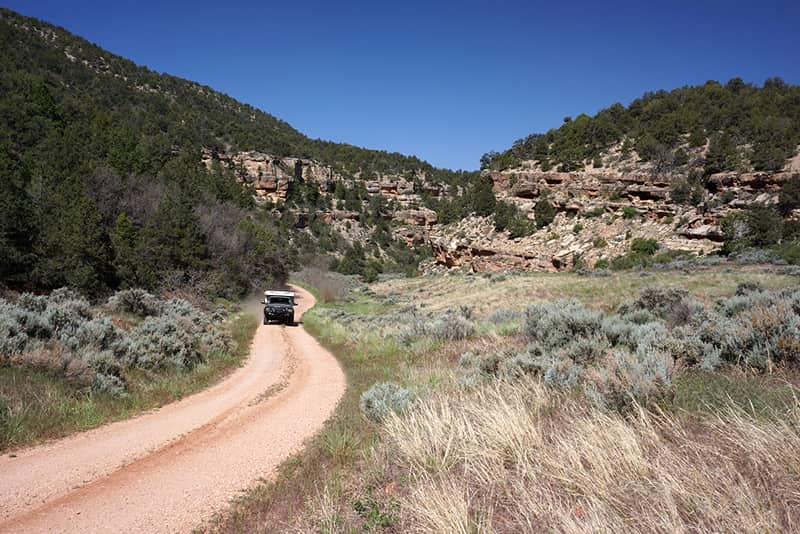
Above: Exploring around the North Rim of the Grand Canyon, Arizona
I later spoke to the Owner of Four Wheel Campers, Tom Hanagan, and discussed what I wanted and what I was going to do. Between talking to the Hansens and Tom, we chose our Four Wheel Camper and set up our rig.
To get away from pavement, you need to think about the vehicle you put together. You need to look at the size and weight of your vehicle. That’s another reason why we chose a Four Wheel Camper. You won’t find a lighter or more capable pop-up truck camper.
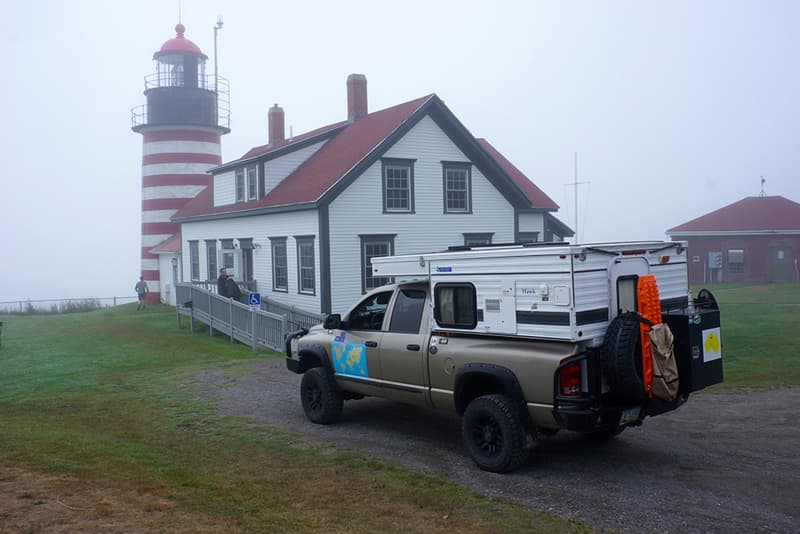
Above: Quoddy Head Lighthouse, note rear bumper system with second spare and tools
TCM: Have you modified your truck and camper for the type of off-road travel you prefer?
Ron: I have set up the vehicle well. We have driving lights and an Aluminess bumper system and an ARB front bumper. The Aluminess is where we carry a second spare tire and all my tools. I also installed a suspension lift, nothing too dramatic, with Rancho shocks.
The Four Wheel Camper has a Fiamma awning that provides shade and a bit of protection from the weather if it’s inclement and I’m cooking outside. The camper also has a built-in water heater. It’s basic, but a good set-up for what we do.
We’ve been traveling together with different rigs for decades. The Four Wheel Camper is luxurious compared to a roof-top tent. We also tend to cook outside with propane. We are always outside when the weather is good. We really only go inside the camper to sleep.
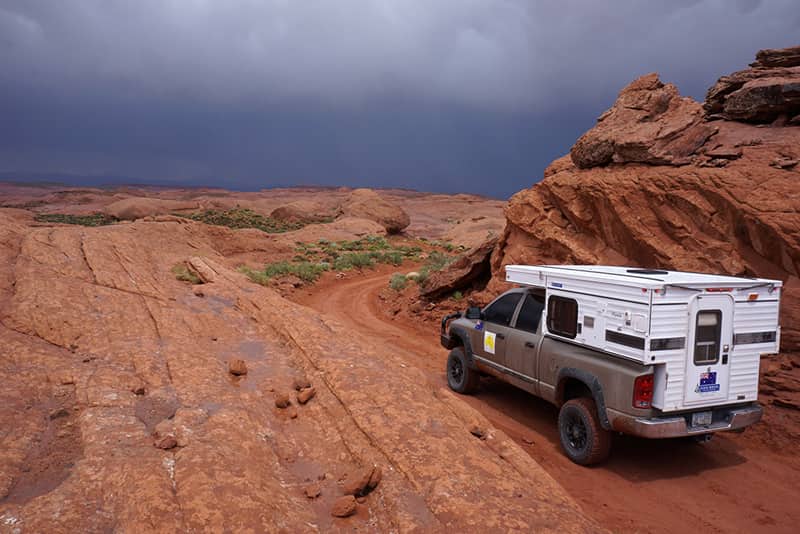
Above: Hole in the Rock Road, Utah
We are really happy with our Four Wheel Camper. It’s a good set-up for the two-track roads we like to travel. It’s exactly the right size to get under trees and around the brush. It wouldn’t suit everyone, but it’s what we like.
TCM: How does it work flying in, picking up your rig, traveling, and then leaving it behind again?
Ron: We have left our rig in the United States or Canada three times. We pull the battery disconnect, drain the water, put some fuel additives in the tank, and put mice stuff around so animals don’t get into it. Then we wrap it up and kiss it goodbye.
I bought an RV cover that also fits the truck. The camper is bolted to the truck and I don’t bother taking it off. As such, we cover the truck and camper together.
We haven’t had any issues storing the rig for extended periods. We leave clothing, bedding, and tools in the rig. Our cameras and computers come back with us. Everything else is in the camper.
We are used to leaving our rig. We just traveled the southwest of the United States. At the end of our trip, we stored our truck camper rig in Arizona.
Last year we finished our travels in Canada and put the rig into storage just outside of Halifax, Nova Scotia. That area is one of the best and cheapest stepping off places to ship a rig from North America and Europe. We stored the rig on a farm that’s used by many overlanders. Then we flew home. We aim to return in the spring. That’s our routine.
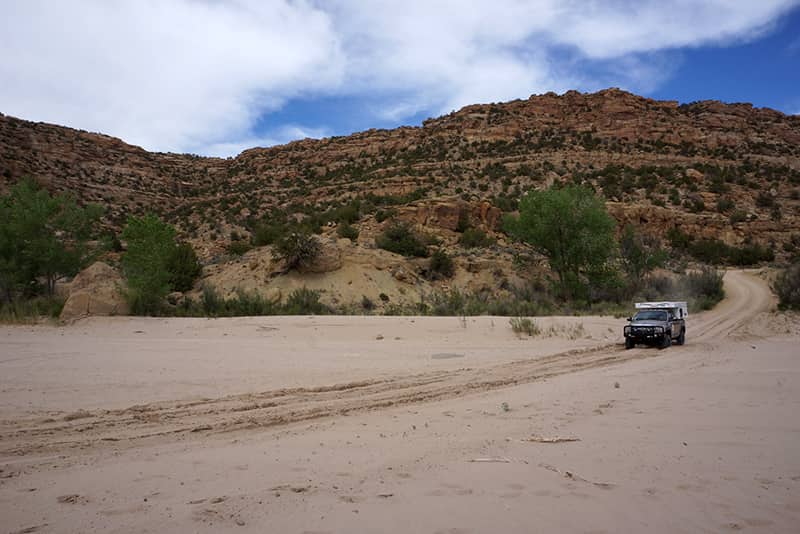
Above: Crow Canyon, New Mexico
TCM: It sounds like you travel every year. Is there a schedule?
Ron: Our whole lifestyle revolves around travel. We spend eight months traveling every year. We may stay a couple of months at home for Christmas with family and friends. Then we’re off in our autumn – March – and hit the road again.
This latest trip was two months, but we can go three months without much effort. Next time we visit the United States we’ll get a full visa for six months. This year we have trips organized in Australia so we need to get back for those. We prefer to stay a bit longer. Next year we want to explore Baja and Mexico’s mainland.
TCM: Do you have a house?
Ron: We have a house in Australia. That’s one of the things we sort out each time we travel; having friends house sit while we’re away. We’ll always have a house and base to return to.
TCM: Buying a truck and camper, flying back and forth from Australia, and traveling are all considerable investments. What brings you back to the United States, Canada, and Mexico?
Ron: We love the American West and its dramatic scenery and variety. We will be coming back to the west for the next few years.
There’s so much spectacular scenery and great camping on BLM and national forest lands. We also have some thoughts on returning to the Yukon and Alaska. We would like to do some rafting up in Alaska. We did a ten-day rafting trip in the Grand Canyon and I’d like to do more of that.
I thought about shipping the Four Wheel Camper to Europe or South America, but we’re going to keep it in North America for the foreseeable future.
TCM: For someone from the United States or Canada that wants to explore Australia in a truck camper, would a similar approach make sense?
Ron: I have presented on that subject at Overland Expo. If you’re going to Australia for less than two months, it’s more economical to hire (rent) a vehicle. If you’re going to stay longer, it makes sense to either ship your own vehicle, or buy a rig there.
If you ship a rig to Australia, your rig will be quarantined for several weeks. Australia is very strict on vehicles entering the country. The vehicle could be fumigated for a cost of $700 USD. I once helped a German couple who had a vehicle impounded for a month. There are always issues with vehicles coming into Australia.
Apart from that, your vehicle can only stay in Australia for 12 months. You can only stay in Australia for 6 months. You could fly to New Zealand for a week and return for another 6 months, but your vehicle must leave the country in 12 months.
My recommendation is to purchase a vehicle and then sell it after your trip. The best place to find a vehicle is carsales.com.au. You’ll find vehicles of every sort on that website.
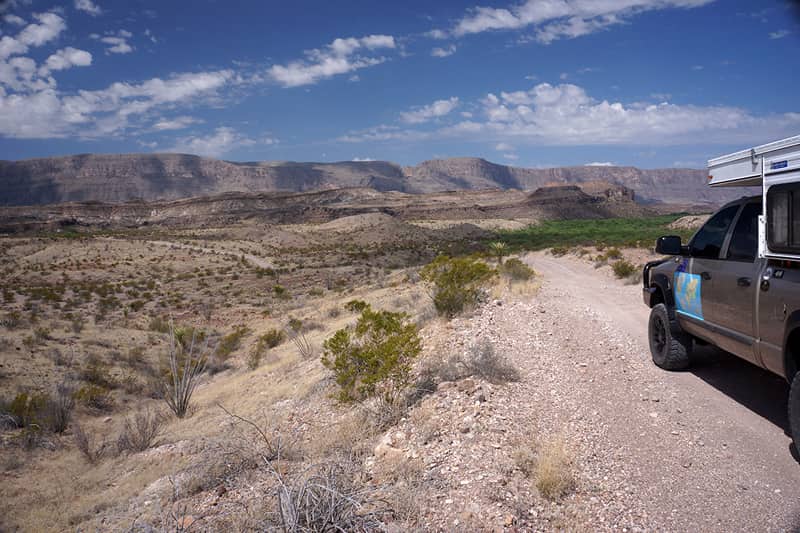
Above: Big Bend National Park along River Road, Texas
TCM: Do you plan your travels, or make it up as you go?
Ron: Generally, we have a broad plan. We stay flexible and rarely book anything ahead. If we hear of anything from passing travelers, we’ll immediately look into their recommendations.
We came back to the United States early to explore Big Bend National Park. When we arrived, we heard about the super bloom in the California desert. So we changed our plans and did that. We traveled to Anza Borrego State Park and missed the peak, but it was still pretty good.
After the super bloom, we went back to Big Bend. Then we turned around and headed north into New Mexico. That was fantastic. Then we explored southern Colorado and Utah. The BLM, national forests, and national parks offer great camping in that area. We really enjoyed it.
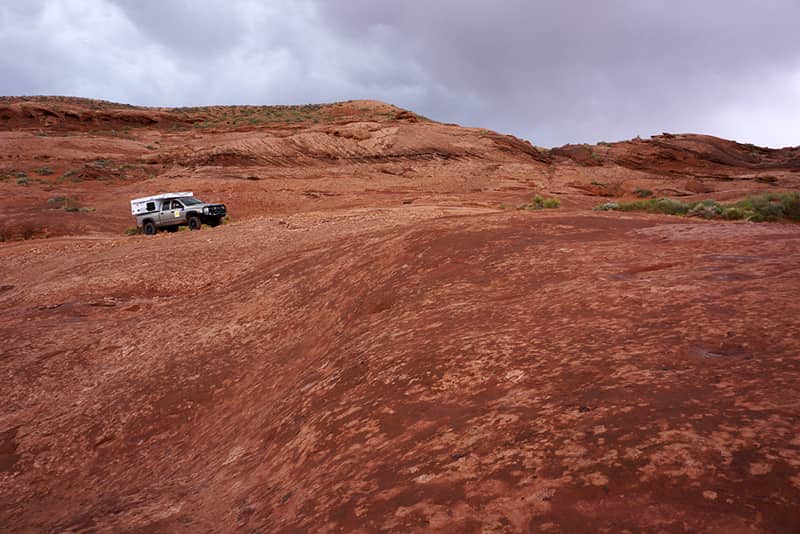
Above: Exploring southern Utah with their Four Wheel Camper
TCM: Your guidebooks and articles are incredible. How do you manage to write while you’re traveling?
Ron: When I’m in America, I take my work to a minimum. To meet our monthly commitments, I write a couple of monthly columns, and Viv writes a cooking column. These articles can be written from anywhere in the world.
When we’re in Australia, we have more commitments. Every now and then we have a contract to write a new guidebook. That’s three to four months of intensive work and research.
TCM: Tell us about your travels in America so far.
Ron: On our original around the world overland trip in 2012 we drove the west coast of North America to the Yukon and then to Prudhoe Bay in Alaska. We also drove the ice roads to Tuktoyaktuk in Canada’s Northwest Territories in 2013.
When we came back in 2014 we bought our Dodge and Four Wheel Camper. For the first four months, we wandered around the southwest. We lost ourselves in the more remote country and environs of Nevada, Arizona, New Mexico, and western Texas before coming back into Utah. After a number of visits, we have voted Utah our favorite state in the lower 48.
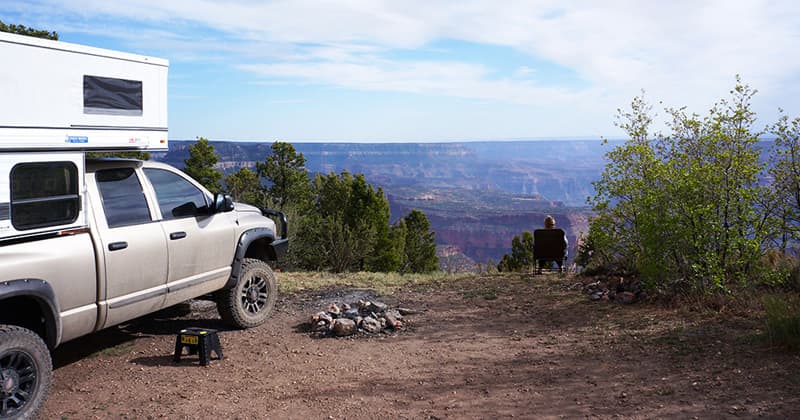
Above: Camping on the edge of the north rim of the Grand Canyon, Arizona
We camped during that foray on the edge of the north rim of the Grand Canyon. We reached the rim via easy forestry roads west of the national park and at Muley Point. Muley Point overlooks a gooseneck in the San Juan River in Glen Canyon National Recreational Area; both perched on the edge of a great chasm. We could never decide which campsite gave the most spectacular view.
In the massive Grand Staircase of Escalante National Monument, we wandered for days on dirt roads and lightly eroded tracks. While we visited the nearby national parks to take in their spectacular offerings – Bryce, Zion, Canyonlands, and Capitol Reef – we generally searched for quieter, more remote places to camp.
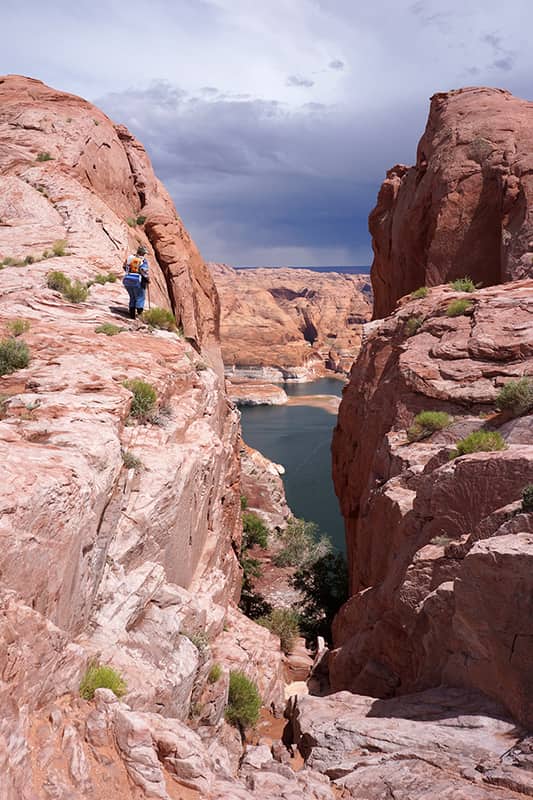
Above: Hole in the Rock, Utah
At the small hamlet of Escalante, we discovered the incredible story of the Mormon pioneers of 1879 and the Hole-in-the-Rock expedition. When we stood on the rim of the canyon at Hole-in-the-Rock, we could not help but be gob-smacked at their endeavors. The end of the track also makes a fine camp and, apart from a small marker and the track itself, the area is unchanged from the days of those trailblazers. We had it to ourselves.
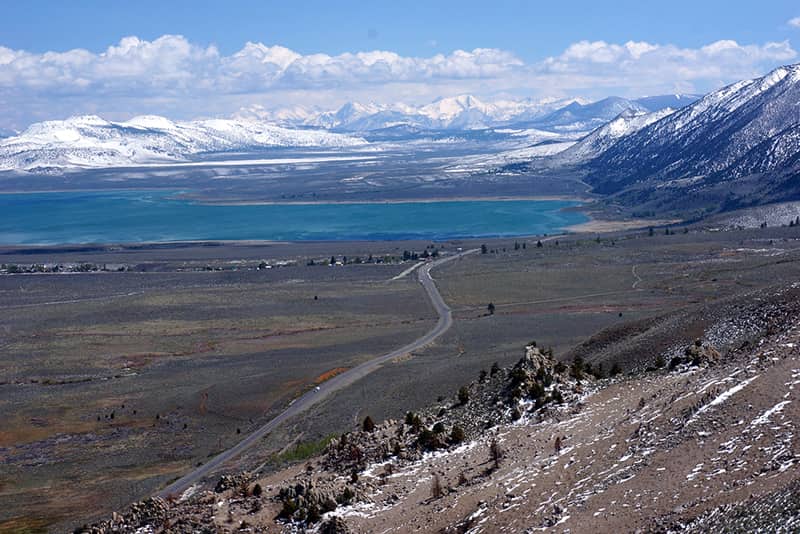
Above: US-395 with the Sierra Nevada’s snow-capped peaks in the distance
TCM: That was your first trip to the American West. What did you do the next year?
Ron: For our second four-month phase the following year, we cruised south from Sacramento with our Four Wheel Camper. We traveled down US-395 with the Sierra Nevada’s snow-capped peaks rearing up from the flat sagebrush plains. It’s a road we never get sick of traveling.
The flat country reminds us of our Australian home soil in many ways, but we lack the rugged snow-capped mountains in the background. If you want to stop for a day or more, we recommend that you swing west up Tioga Pass to the verdant delights; lakes, and pines of Yosemite or east to the tan and tawny blistering hot depths of Death Valley.
We stopped at the Overland Expo West at Mormon Lake, meeting up with old friends and making a heap of new acquaintances, before taking a nine-day rafting trip down the Grand Canyon. Now that is something else, worthy of a story in itself. Suffice it to say I’m looking for another stream to spend some time rafting.
TCM: And from there you ventured into Mexico. Where did you cross the border?
Ron: We passed through the Mexican border at Nogales and wandered down the coast of the Gulf of California, although we favor its alternate name, the Sea of Cortez. We like the Baja coast of the gulf much more than this mainland shoreline, but you don’t know that when you start out.
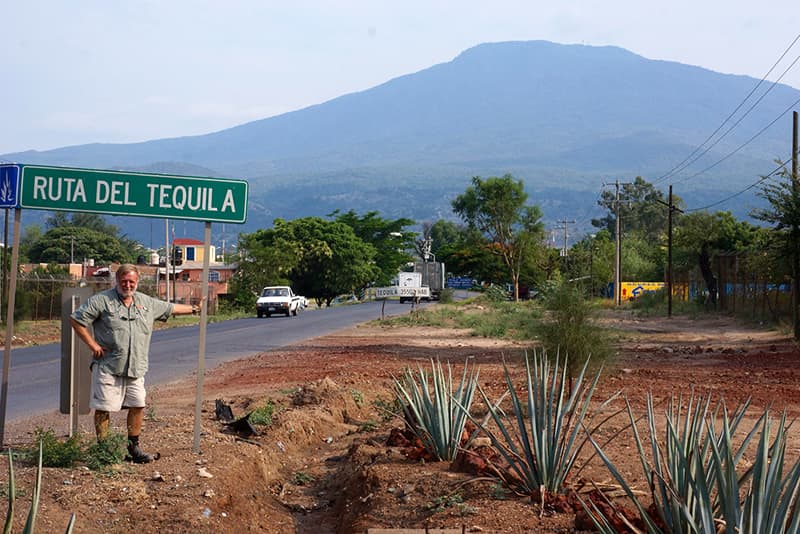
Above: La Ruta del Tequila, Mexico
We picked up the La Ruta del Tequila (The Tequila Trail) and wandered inland through hills and farmland lined with the blue weber agave plant that is the only agave species that produces tequila. We should have stopped at the small historic and friendly towns of Magdalena or Tequila itself for longer, but we pushed on.
Passing through Mexico’s second-largest city of Guadalajara on a Friday afternoon in peak hour, we had the misfortune to be pulled over by a motorcycle cop. These lone sharks are the worse breed of police we’ve found in our nine years of overlanding the planet.
TCM: That must have been frightening. How did you handle that?
Ron: We spent a half-hour arguing with him about a fine and monies to be paid. Finally, he waved us away – it was dark by then – and we pulled up in a big truck stop behind a Pemex fuel station and called it a camp for the night. In all our travels in Mexico and North America, that has been the only time we have been hassled by a crook cop.
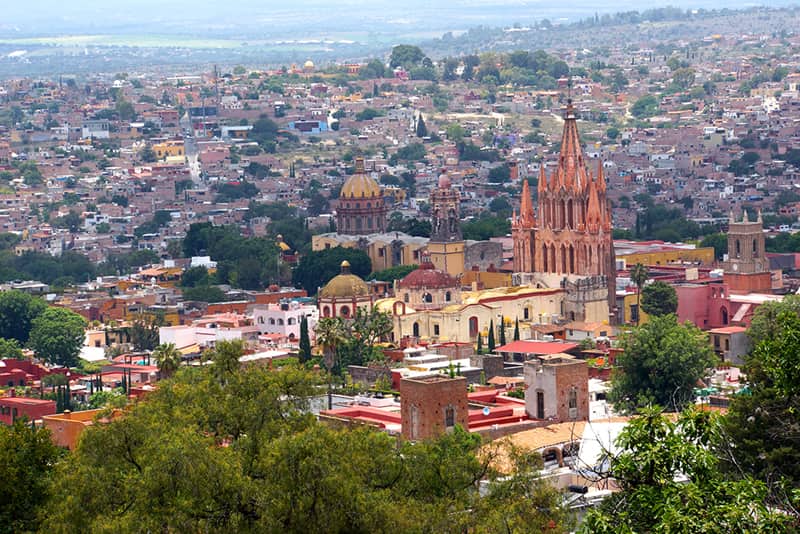
Above: San Miguel de Allende, Mexico
TCM: Where did you go after that experience?
Ron: Over the next two weeks we followed portions of the Camino Real de Tierra Adentro, the first route traced by the Spaniards in America. It was also known as the Royal Inland Road. Most of it has been swallowed under the asphalt of freeways and pot-holed black-topped highways, but you can still find the occasional dirt road section that harks back to an earlier time.
We propped in the historic town and World Heritage Site of San Miguel de Allende, once an important part of the Royal Road. There we took in the sites of this fabulous town and met other world overlanders who were using the popular small campground in the heart of the village as a base to explore the local area.
To explore Mexico City a little further south, we stopped at another favored overlander camp – Pepe’s Hotel.
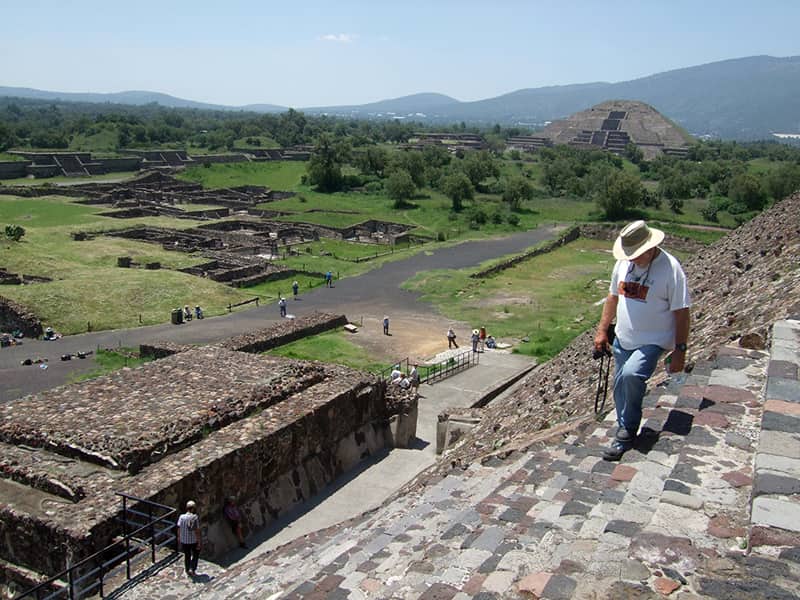
Above: The Teotihuacan Pyramids
Once again we rubbed shoulders with German and Swiss travelers as we took in the Teotihuacan Pyramids.
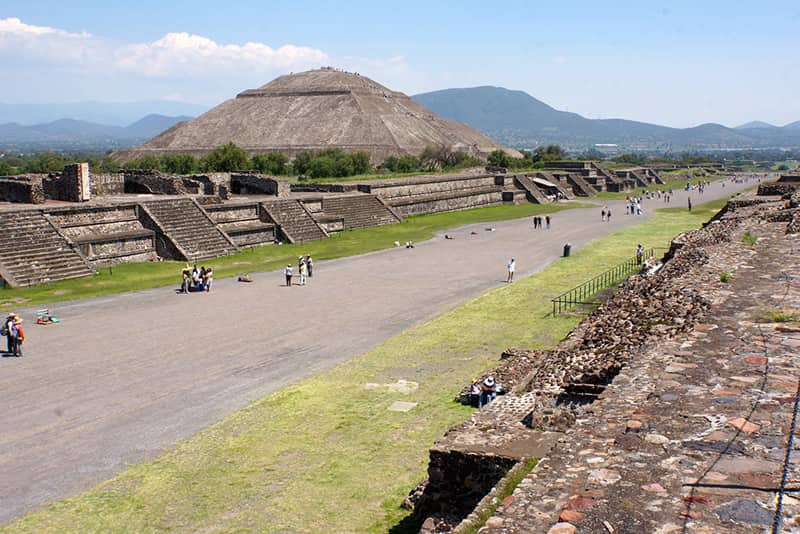
TCM: The photos of the Teotihuacan Pyramids are very compelling. We would love to do that.
Ron: It’s great. Do it!
Once we swung north from Mexico City we crossed back into the USA at Laredo, Texas. With an Independence Day holiday looming, we headed for the gulf coast, south of Corpus Christie, to hide from the crowds along the Padre Island National Seashore.
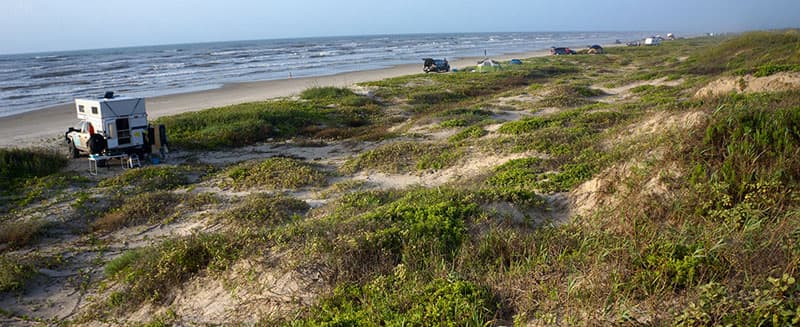
Above: Camping on Padre Island, Texas
It was okay but, as we’ve found on our world-wide Overlanding ventures, not too many strips of sand can compete with our Aussie beaches. Then again, you can assume I’m pretty biased.
One thing we did in the southeast of Texas was to take a tour of the impressive King Ranch. The King Ranch once owned sprawling properties in Australia and introduced, amongst other innovations, the Santa Gertrudis breed of cattle to northern Australia.
Still the biggest ranch in the USA stretching across nearly 400,000 acres, it runs 35,000 cattle and 200 fine quarter horses, along with vast areas of cropping plus wilder areas for recreational hunting and bird watching. The property employs around 100 people, most of who are 4th or 5th generation workers on the place. It has its own school and small town along with a museum which runs popular tours of the sprawling estate every day of the year.
TCM: Where did you go after Texas?
Ron: Once the traffic had thinned and with less lucky souls having gone back to work, we poked our way through eastern Texas to Arkansas and Tennessee and to the Great Smoky Mountains National Park before heading along the Blue Ridge Parkway to Washington DC and its incredible monuments and museums.
For road history buffs, the Transport Hall of the Museum of National History in Washington is a must-do. Amongst the displays is an impressive presentation of the first motor vehicle to drive across America. The 1903 20HP Winton driven by Horatio Nelson Jackson (we wonder who he was named after) and Sewall K. Crocker, took 63 days to drive from San Francisco to New York. The Winton takes pride of place in the hall – as it should.
We got to New York a week or so later after leaving Washington DC, going there via Gettysburg (man, you Americans do your historic and battlefield monuments exceedingly well), but we could have easily bypassed the Big Apple.
TCM: In our opinion, Gettysburg has the most impressive visitor’s center in the whole national park system. And we bypass New York and most other major cities as well.
Ron: I’m glad you feel that way. It makes us feel less lonely!
Leaving New York, we headed to Acadia National Park. My diary for the trip stated that we passed through four states in the one day – New Jersey, New York, Massachusetts and then Vermont – before we found a pleasant camp in a state park surrounded by the verdant forests of eastern America.
When we got there, the national park was crowded, so we pushed on to lesser-known and less populated fields including West Quoddy Point Lighthouse – which is the most easterly point of the USA.
TCM: That is an amazing travelogue, and brings us up to your third trip to America in 2016.
Ron: Our third year (2016) of traveling in North America in our Four Wheel Camper started with our excursion to Meat Cove before we caught the car ferry to Newfoundland. Meat Cove is located close to the northern tip of Cape Breton Island, Nova Scotia.

Above: Meat Cove camping area, Nova Scotia
The camping area of the same name – not a glamorous one to be sure – is perched on the steep rounded hills overlooking the bay where precipitous jagged cliffs plunge into the cool waters of the north Atlantic Ocean.
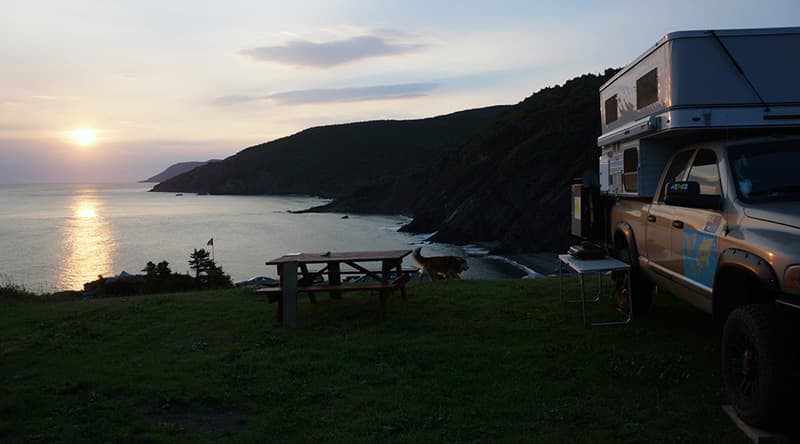
Above: Meat Cove camping, Nova Scotia
It is an impressive place with gannets wheeling overhead and dolphins and whales cruising offshore. It was one of the best camps we have had in our traverse across North America and probably the only one in the east of that magnificent continent I’d go back to. But, as proof of the old saying that there is no perfect place, that was where we found the irritation and annoyance of Canada’s ferocious biting black flies.
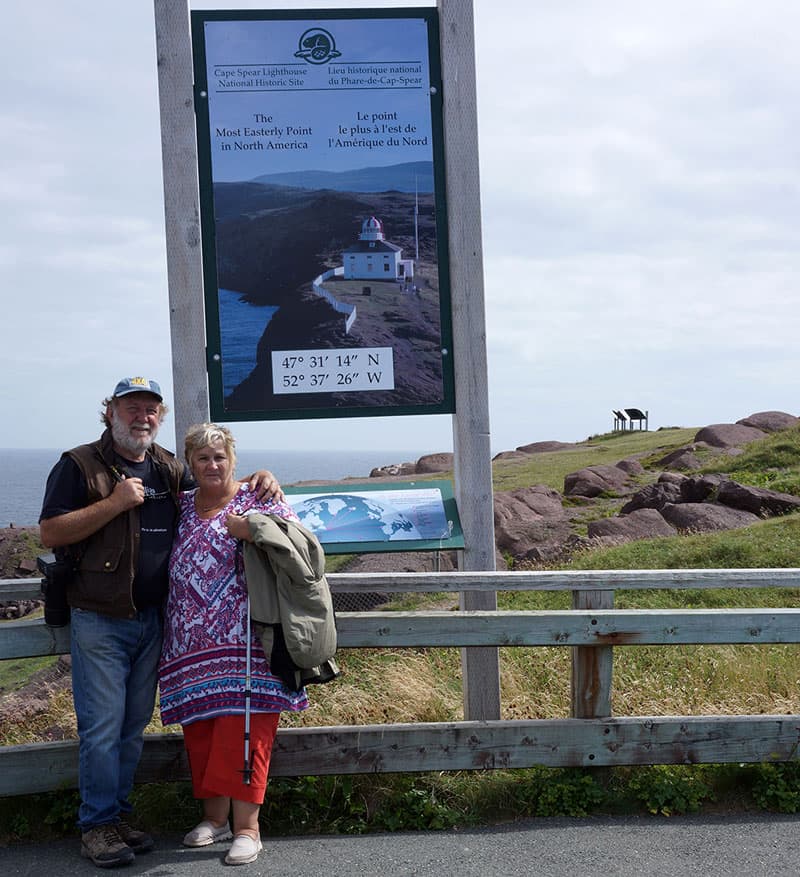
Above: Cape Spear, the most easterly point of the North American continent
TCM: There are no perfect places, but some are more perfect than others. What was your next destination?
Ron: We found our way to the most easterly point of the North American continent at Cape Spear. There another historic lighthouse shines its light across a tremulous and cold ocean. During World War 2, a US detachment of troops helped man the important heavy artillery base, but they saw no action and left it as they had found it, “Cold, clammy, foggy and miserable”.
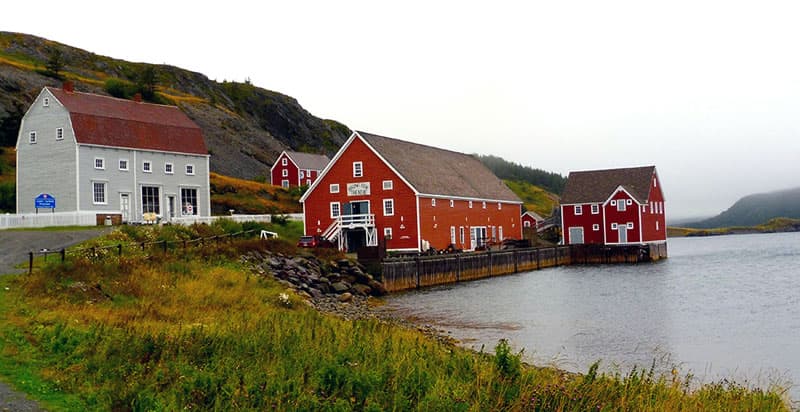
Above: Outport of Trinity, Newfoundland
We didn’t find it that bad on a pleasant summer’s day, but we didn’t stay long either. We headed west visiting some of the historic outports that dot the indented coast; old harbors and anchorages that once shipped cod and seal skins out to Europe.
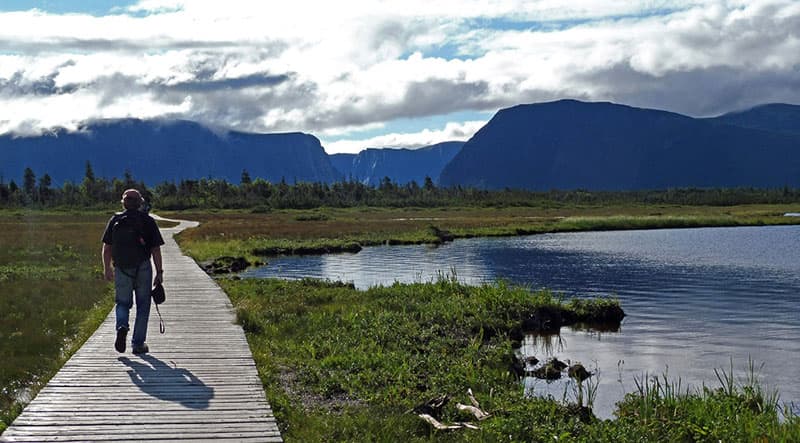
Above: Western Brook Pond, Gros Morne National Park, Newfoundland
We then checked out the province’s biggest reserved area, Gros Morne National Park, and its impressive Western Brook Pond. Western Brook Pond is only reached by a 1.7 mile walk and then a boat ride.
Later we visited the one place not to miss in northern Newfoundland, the exceptional, L’Anse aux Meadows National Historic Site, the only confirmed Viking settlement in North America.
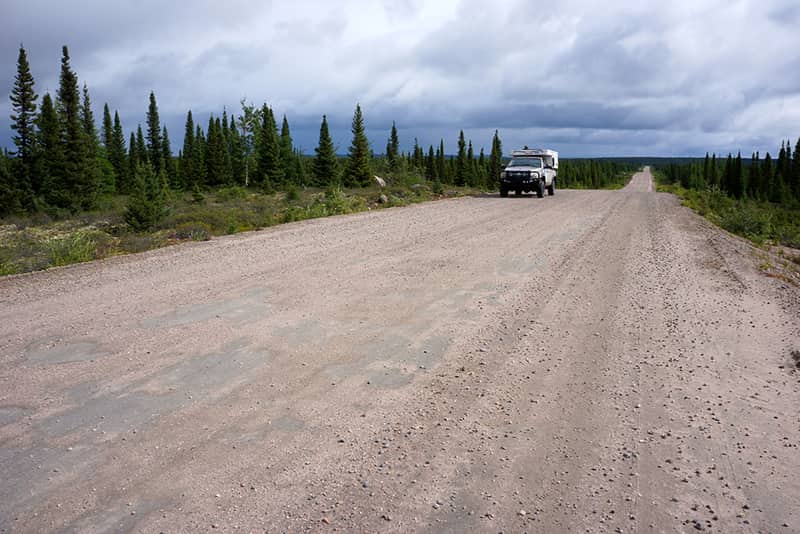
Above: Only road north from Blanc-Sablon, Labrador
TCM: Another spot for the bucket list.
Ron: With yet another ferry ride across the Gulf of St. Lawrence, we landed in Labrador and took the long sweep of dirt and muddy road north, and then west, to Happy Valley-Goose Bay.
This is a pretty remote part of the planet, but things are changing rapidly. Two hydro dams and power developments are pushing a long, wide, and sinuous power line through the virgin forest and across the bogs and marshes of remote eastern Canada. Soon the whole route from Blanc-Sablon, where the ferry deposits you in Labrador, to Goose Bay will be boring pavement.
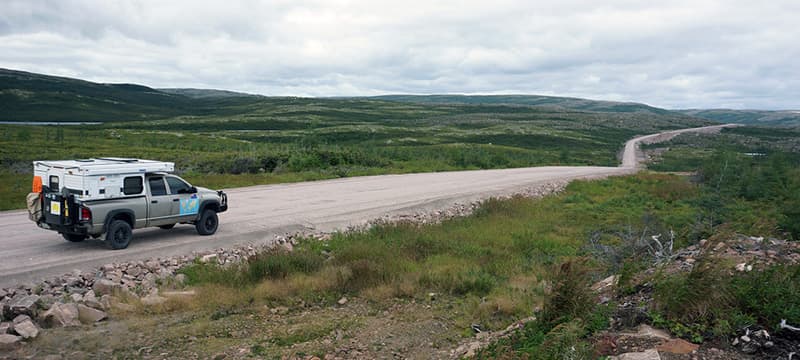
Above: Dirt road near Blanc-Sablon, Labrador
From the industrial-come residential base of Goose Bay, we found our way through the remote parts of the province of Quebec to the historic capital on the Saint Lawrence River. The old walled town of Quebec is the only such fortified city in all of North America.
TCM: We have always wanted to visit Quebec. What was that city like?
Ron: We enjoyed the old part of the city and the history, but Quebec and its French-speaking citizens are, it seems to us, a bit of an anomaly in the wider, and more populated expanses of Canada. Certainly, Quebec feels like a different country with its French-only signs, language, and customs. To be honest, we felt more like an outsider there than in any other province in Canada.
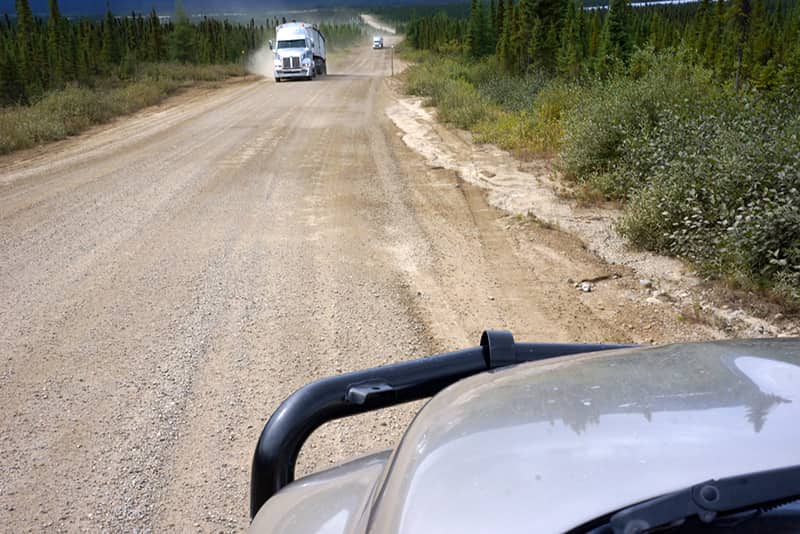
Above: Dirt road in North Quebec
Sick of the crowds and looking for quieter quarters, we headed north from Quebec and then west on roads used mainly by logging trucks, hydro workers’ pick-ups, or mining exploration vehicles.
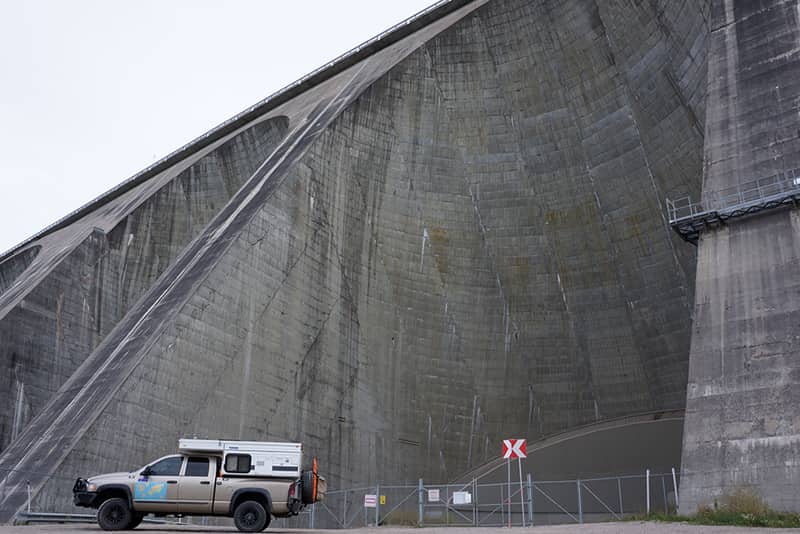
Above: Big dam in northern Quebec
At one lonely camp on the edge of a small nature reserve, we had a black bear take an uncommon amount of interest in our vehicle, waking us up as he pushed the back end of the Ram this way and that, before wandering off into the dark.
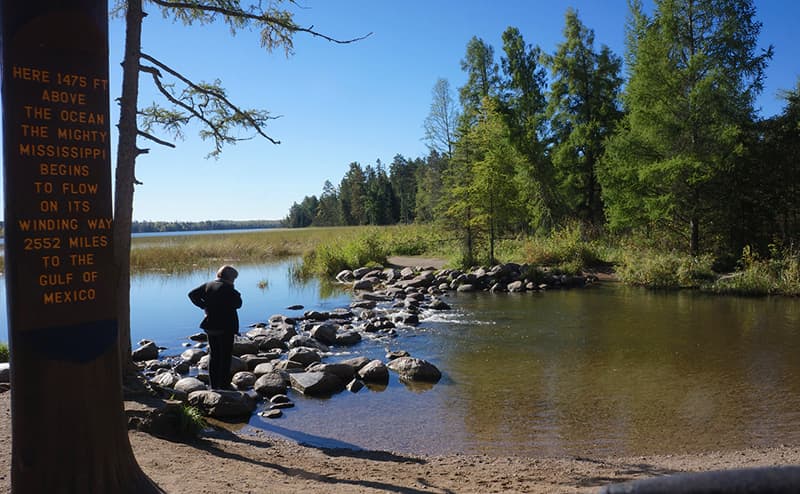
Above: Minnesota, headwaters of the Mississippi, Lake Itasca State Park
TCM: That’s quite a bear story. We have seen plenty of bears in our travels but never had one approach our vehicle. Where did you cross back into the United States?
Ron: We crossed the border back into the USA at Minnesota, finding the headwaters of the mighty Mississippi in the pleasant Lake Itasca State Park. Heading ever westward the next day (in our quest now to reach the most westerly point of the USA) we stopped for a quick photo at the Geographical Center of North America in Rugby, North Dakota. There might be some discussion as to whether that is the actual geographical center of the continent, but Rugby has claimed it and with no other real obvious contenders, it’ll do us.
The fracking and subsequent oil and gas boom that has gripped North Dakota has done little to enhance the natural rolling grasslands. That’s a shame really but, as I burn diesel traveling the planet, we can’t really complain much, can we?
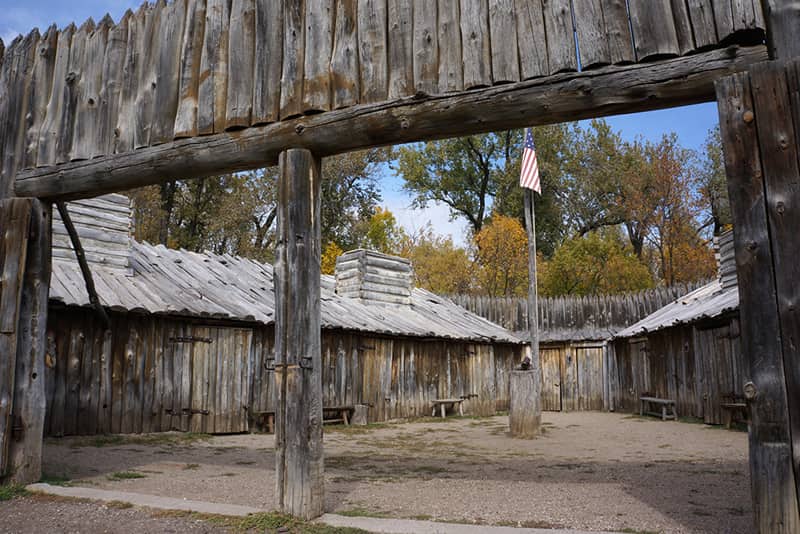
Above: Reconstructed Fort Mandan, Lewis and Clark monument
TCM: No, we can’t. We have driven past some extensive fracking operations in Colorado and Pennsylvania. How did you continue your path west?
Ron: South of Lake Sakakawea, on a much-tamed Missouri River, we came to our first Lewis and Clark monument at a reconstructed Fort Mandan. That great expedition had wintered there in 1804-05. If you are a fan of their travels and endeavors (like we are) this is one place not to miss.
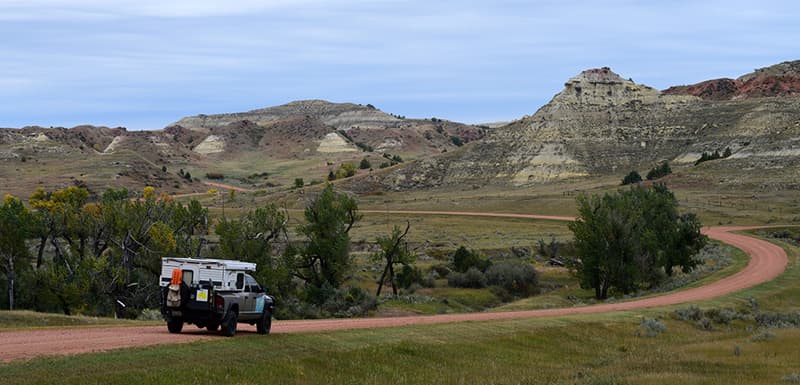
Above: Badlands, North Dakota
For the next few days, we wandered the badlands in and around Theodore Roosevelt National Park. We reveled in being back in the west, finding some dirt roads and rougher tracks to explore, discovering more remote campsites, and enjoying the wildlife – bison, pronghorn antelope, mule deer, and bighorn sheep.
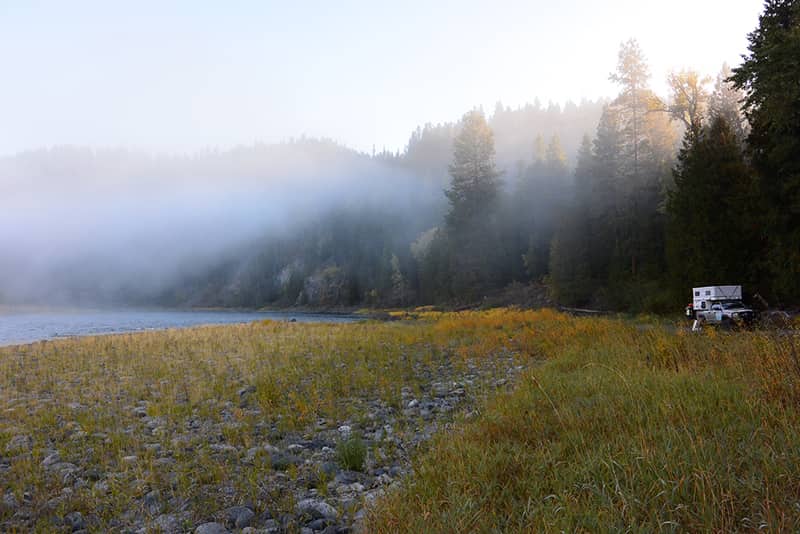
Above: Boondocking in Montana
Pushing further west, we found ourselves in the Rockies with the fabulous Glacier National Park to enjoy. Then we explored the Cascades with its impressive Mount Rainer, enjoying a fortunate day when it was clear and the mountain stood proud of its surrounds of pine forest and tranquil lakes.
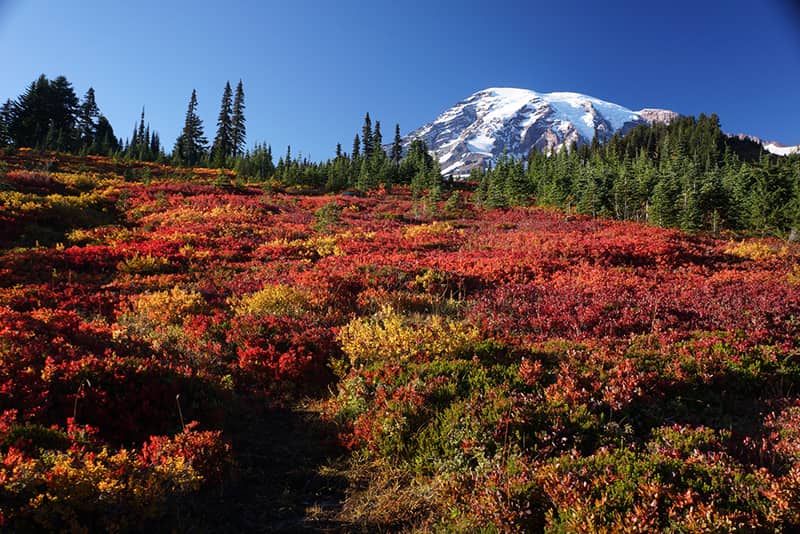
Above: Mount Rainer, Washington
Circumventing the built up areas of Tacoma and its surrounds in northern Washington state, we found our way around Olympic National Park and skirted along the Strait of Juan de Fuca to the Makah Indian Reservation and the small community of Neah Bay.
Five miles further on a car park marks the road’s end. From there it is a half-mile walk through Pacific temperate rainforest of tall and ancient Sitka spruce to the rocky, heavily indented coast at Cape Flattery. Named by that eminent navigator and explorer, Captain James Cook, it shares its name with an even more remote Cape Flattery in Queensland, Australia. This one is the most western point of the lower 48, and it’s a long, long way from the most eastern point of the North American continent, we can assure you.
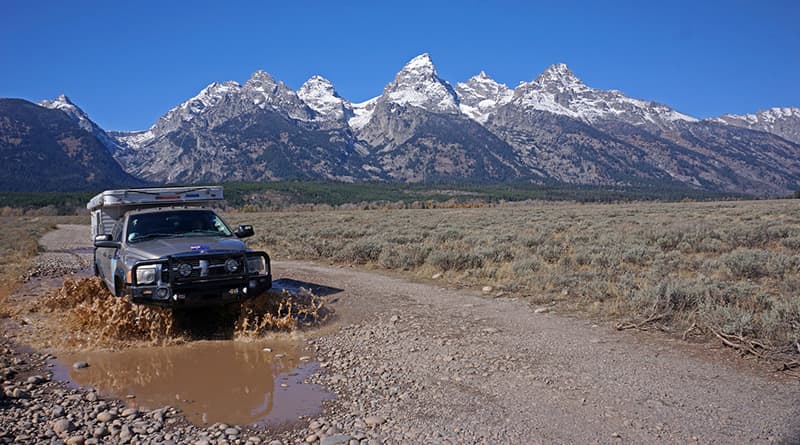
Above: Grand Tetons, Wyoming
TCM: Was your trip completed now that you had traveled from the eastern-most point to the western-most point?
Ron: Not yet. We turned south and then east, taking us through some of the finest country in the whole continent in Oregon, Idaho, Wyoming, and Colorado. Our route is always searching for dirt roads and less used campsites.
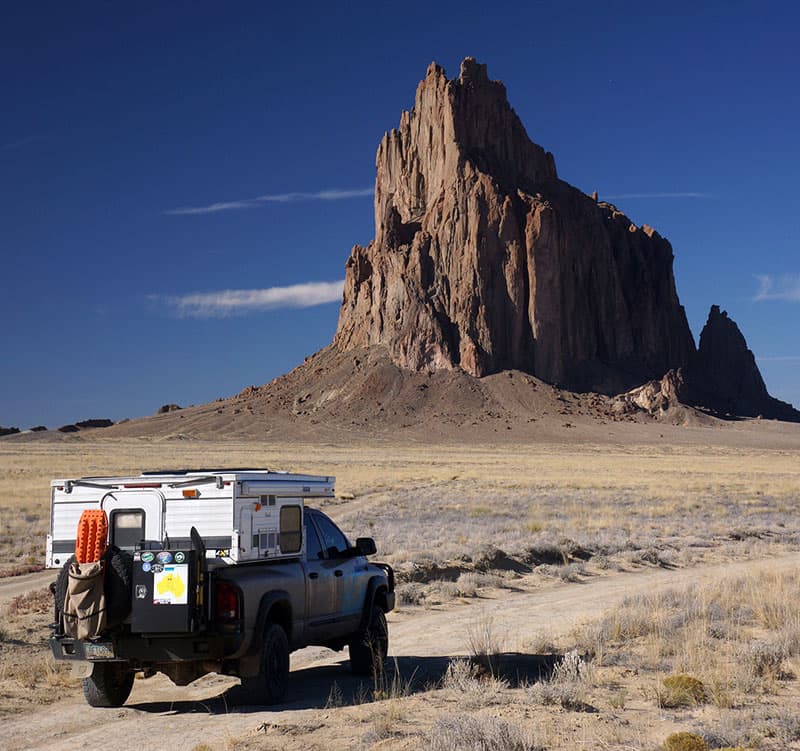
Above: The road to Shiprock in New Mexico
For a final encore, we camped under the towering bulk of Shiprock in New Mexico and then crossed the border to camp overlooking the little-known and even less visited Coal Mine Canyon in northeastern Arizona. It was a fitting end to our travels. As we were placing the Ram into storage for another year, we were already drawing up plans to return.
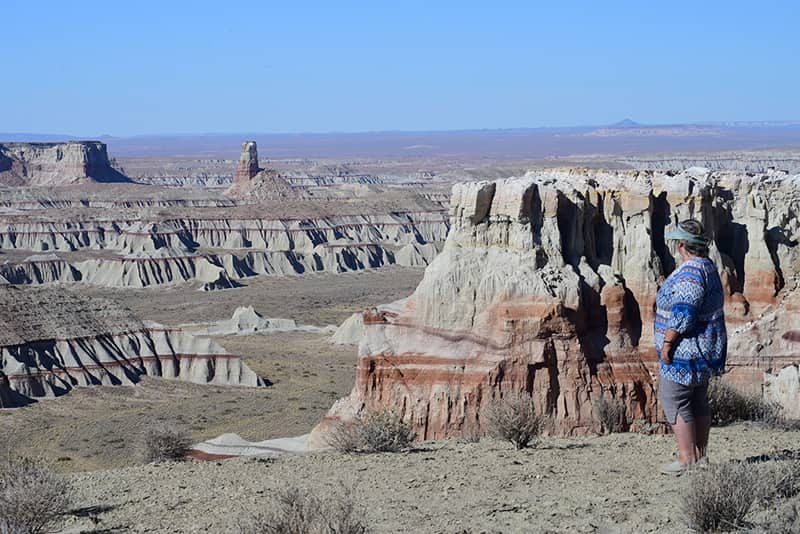
Above: Coal Mine Canyon in northeastern Arizona
In all, we’ve spent thirteen months over the last four years and traveled 42,000 miles in North America. Our love affair for the west though is barely sated!
TCM: We know that feeling. The west is a tough itch to scratch permanently. Do you have any advice for someone who wants to follow in your tire tracks and explore the world in an overland rig?
Ron: I always tell people to set a date. Don’t keep saying, “I’m going to do that one day.” We set a date in 2008 to ship our truck to South America. Another time we set a date to drive into Mexico. You have to set a date or it doesn’t happen.
Another important tip is to forget what you hear on the news. Everything in the news is bad news. Read the hundreds of online blogs from fellow travelers. The blogs give you the best insights into what is really going on in the areas you want to travel. Then spread your wings and go for it.
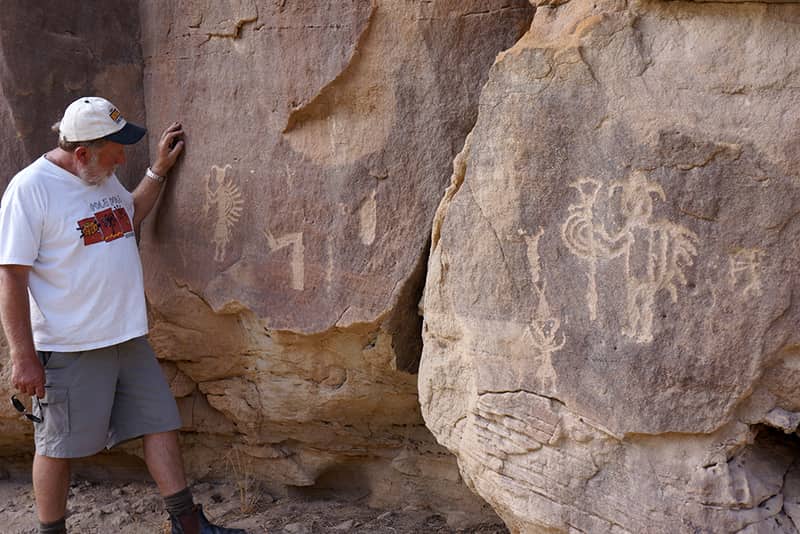
Above: Navajo rock art in Crow Canyon, New Mexico
The United States is a great country to enjoy. Canada is easy. When you head to Mexico and Baja, the people are friendly. You may get a few police roadblocks, but they’re not a big deal.
With those experiences behind you, you can look further and further. North America is a huge continent to explore, but there are other amazing places to see. You can drive into South America. The whole world is at your feet.
I recommend going to the Overland Expo and talking to other travelers. Then take it easy. Learn along the way. Don’t rush anything. And have a great time.
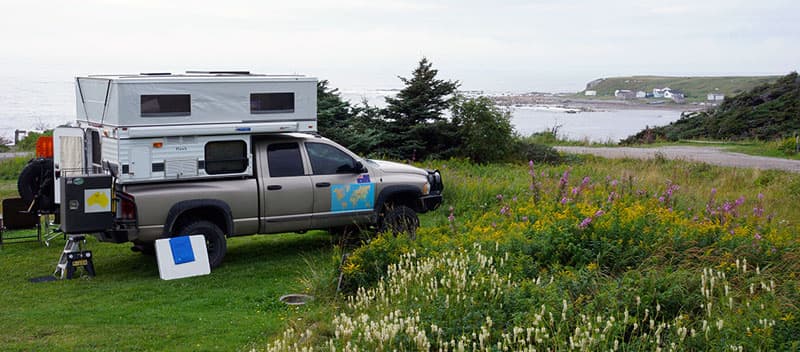
Above: Green Point Camp, Newfoundland
TCM: You make international travel sound easy, but most of us would be concerned about getting ourselves into trouble in a foreign country. Is that a legitimate concern?
Ron: The key to international travel is to stay flexible. In Africa and South America, politics can change rapidly. You need to stay aware of what’s happening around you. If something is going on, your safest route may change.
When we were in Bolivia and went to cross into Peru, there was a demonstration. We had to drive a 1,200-mile detour to get around it. Those situations can happen. You just need to stay flexible.
Australia is as big as the lower 48 states. There are no borders or police to worry about. No bribes to pay. Traveling in North America and Australia are similar in that regard. If you’re new to international travel, explore Australia before traveling to Africa or South America. That said, Africa pays you back 10-fold in absolute enjoyment and wonder. It’s well worth it.
To read more about our travels and to see our guide books, please visit our website at guidebooks.com.au. To visit the Four Wheel website, go to fourwheelcampers.com. Click here for a free Four Wheel brochure.
Ron and Viv’s Rig
Truck: 2005 Dodge Ram 2500, four wheel drive, crew cab, diesel
Camper: 2014 Four Wheel Camper Hawk
Tie-Downs/Turnbuckles: Bolted permanently to the floor of the truck
Suspension: Rancho shocks, Tuftruck coil, SDTrucksprings rear leaf springs
Gear: ARB front bumper, IPF driving lights, Aluminess rear bumper with storage box and tire carrier, Cooper ST Maxx tires









